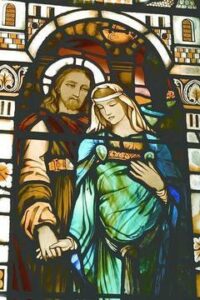Klaus Mailahn posted:
Oils as symbol of Divine Mother Ruah / Ruach
Last night at BibleTV I saw an interesting sermon of famous US-preacher Bayless Conley. At the beginning he spoke of the Holy Spirit (we call Mother Ruah / Ruach). One of Her most important symbols has been oil, especially oil of anointing and oil for lamps! This special assignment seems to be an indication for the connection between Mother Ruah and Mary Magdalene. For oil of anointing brings to mind Mary Magdalene appearing as Sulamith in Song of Solomon / Song of Songs. Oil for lamps of course has to do with light – and Mary Magdalene is the Pure of Light in the Pistis Sophia and the Illuminated in the Gnosis. William Henry in one of his books calls Her in his subtitle “Illuminator. The woman who enlighted Christ”. In the Revelation 12, Mary Magdalene appears as The Woman clothed with the Sun.
We now can understand better why Hippolyte of Rome (170-236) in his Commentary on the Song of Songs associates Mary Magdalene with Ruah, particularly here:
On Song of Songs 4:1f.: “Look, my friend, my lovely, your are beautiful, your eyes are like doves.” The bridegroom calls this out to Sulamith, in Hippolyte’s opinion, because he has seen the Holy Spirit (Mother Ruah). So Sulamith is associated with Ruah. Writing about the Song of Songs 3:1-4 Hippolyte identifies Sulamith with Mary Magdalene, calls Her “Apostle” and “New Eve”. Commenting on the women going to the tomb of Christ he writes: “Oh, the new instruction, Eve becomes Apostle!”
Mary Magdalene and the Force
On Song of Songs 2:5: “Anoint me with oil and gather apples”. Here Hippolyte defines the oil of anointing as “the force teaching us all, fortifying Christ to the inner human”. So this means Mary Magdalene’s oil of anointing strengthens our connection to Christ. And the apple of Eve is the old symbol of the goddess of love, Aphrodite, identified with Mary Magdalene. Â For more on Aphrodite and Mary Magdalene see Ariadne Green: “The mythology of Jesus and Mary Magdalene” http://www.newageinfo.com/myth-Jesus-Magdalene.htm
Margaret Starbird writes of Magdalene the Myrrhophore
Thank you for posting this, Klaus. The connection between Mary Magdalene as “ointment bearer†(Myrrhophore) and the Bride in the Songs of Songs [Solomon] is of immense importance! In the Song of Songs / Solomon, the fragrance of the bride wafts around the king at the banqueting table. In John 12, her fragrance “filled the house.†In both case the fragrance is “nard.†The only passages in all of the Judeo-Christian scriptures where “nard†is mentioned are the Song of Songs and the anointing of Jesus in all four Gospels by “the woman with the alabaster jar.â€â€”
Here are several quotes referencing the “oils†or “fragrance†of the bride:
While the king was on his couch, my nard gave
forth its fragrance. (Song of Solomon 1:12)
Mary took a pound of costly perfume made of
pure nard and anointed Jesus’ feet and wiped
them with her hair. (John 12:3a)
How sweet is your love, my sister, my bride.
How much better…is the fragrance of your oils
than any spice! (Song of Solomon 4:10)
The house was filled with the fragrance of the perfume…
and Jesus said, “Leave her alone so that she might
keep it for the day of my burial. (John 12 3b, 7)
The only anointing of Jesus during his ministry was by the woman whom Luke calls a sinner, but John names: She is Mary, the sister of Lazarus. As I pointed out recently on this list, the “Vesica Pisces†associated by gematria (153) with Mary Magdalene’s title is used as a symbol for the “anointing by the Holy Spirit†in Christian art—
Here’s what I posted a week or two ago: “Often when you see a medieval sculpture of Christ seated in glory, he is surrounded by the “vesica piscis†() symbol (the yoni) which is universally associated with the goddesses of love and fertility. In Christianity, the meaning of the () is “anointed by the Holy Spiritâ€â€”acknowledging that She is feminine….
In the Gospels themselves, Jesus is anointed by a woman named twice in John’s Gospel (11:2 and 12:3). She is Mary, the sister of Lazarus, associated in Christian art and tradition (until recently!) with the Mary whose title is “the Magdalene,†the one who cries at Jesus’ tomb and meets him resurrected in the Garden on Easter morning.â€
This association of the “anointing†with the “Bride†derives from the rituals of fertility cults of the ancient Near East where the bridegroom was anointed by his “Bride†as a prefiguring symbolic of the anointing of the male by the female during coitus. The “vesica piscis†symbol is equated universally with the yoni. Greeks called the symbol the “Matrix,†the “womb,†the “doorway to life†and the “Holy of Holies†– literally the “bridal chamber.†So the use of the vesica piscis in Christian art is a “carry-over†from the ancient rites of heiros gamos—the marriage of the Sacred King and his Holy Bride, who is the representative of the Goddess of the land and people.
Mary Magdalene is clearly cast in the role of the Bride in the Gospels—clearly the instrument of the Holy Spirit anointing the King in advance for his death and burial.
In memory of her,
Margaret
www.margaretstarbird.net
“The Woman with the Alabaster Jar”
